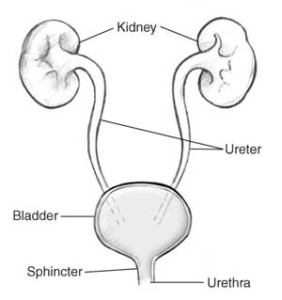

MedFriendly®


Urinary bladder
Bladder has several possible meanings. Sometimes it is
used to refer to a pouch forming part of an animal's
body. More generally, it refers to a muscular organ that
can widen to hold fluid and secretions (substances
released) by the body. A bladder also contains a
membrane, which is a thin layer of flexible tissue that
covers something. Most commonly, the term “bladder”
is used to refer to the urinary bladder, which the rest of
this entry is devoted to.
FEATURED BOOK: General Urology
The urinary tract
The urinary bladder is a hollow, muscular organ in the body that collects and temporarily
holds urine until it is ready to leave the body. Think of the urinary bladder as being like a
stretchable bag.
HOW MUCH CAN THE URINARY BLADDER HOLD?
An adult urinary bladder can hold about a pint of urine. A pint is equal to 2 cups or 16
ounces. To picture how much this is, look at a bottle of soda that is 16 ounces.
WHERE IS THE URINARY BLADDER LOCATED?
The urinary bladder is located behind the pubic bone and is protected within the pelvis.
The pelvis is a massive bone made of hip bones on each side and the front, while the
The pubic bone is located at the front part of the pelvis. Another way to describe where
the urinary bladder is located is to say that it is in front of the rear end.
"Where Medical Information is Easy to Understand"™
WHAT IS THE URINARY BLADDER MADE OF?
As was mentioned earlier, the urinary bladder is a muscular organ.
The urinary bladder also has a thick muscular wall and contains an
inner lining called urinary epithelium. The inner lining contains many
tiny folds that allow it to stretch out. At the back of the urinary
bladder are two connecting tubes known as ureters. The ureters
are two tube-shaped structures that bring urine to the urinary
bladder from the kidneys. The kidneys are two organs located on
each side of the spine, behind the stomach. The kidneys filter
(remove) wastes from the blood.

At the lowest part of the urinary bladder (known as the neck) is an opening into a tube-shaped structure
known as the urethra that drains urine from the body. The opening from the bladder to the urethra is
normally kept tightly closed by a circular muscle known as a sphincter. The urinary bladder, ureters,
kidneys, and urethra, are known together as the urinary system or the urinary tract. The urinary tract is
pictured above.
HOW DOES SOMEBODY KNOW WHEN TO URINATE?
When the urinary bladder becomes filled with urine, it stretches out. When it stretches beyond a certain
point, nerves in the wall of the bladder send a message to the spine. The spine sends a message to the
brain, which is experienced by the body as discomfort. This signals to the person that it is time to urinate.
When the person decides to urinate, nerve centers in the spine cause the muscle around the urethra (the
tube leaving from the bladder) to relax. This causes the main bladder muscle to shorten, which pushes
urine outside of the body through the urethra.
HOW DOES SOMEBODY KNOW WHEN TO URINATE?
When the urinary bladder becomes filled with urine, it stretches out. When it stretches beyond a certain
point, nerves in the wall of the bladder send a message to the spine. The spine sends a message to the
brain, which is experienced by the body as discomfort. This signals to the person that it is time to urinate.
When the person decides to urinate, nerve centers in the spine cause the muscle around the urethra (the
tube leaving from the bladder) to relax. This causes the main bladder muscle to shorten, which pushes
urine outside of the body through the urethra.
HOW DOES SOMEBODY RESIST THE URGE TO URNATE?
A person can resist the urge to urinate by desiring not to. This desire, registered in the brain, sends out
signals to stop the bladder from emptying.
CAN A PERSON RESIST URINATING FOR AS LONG AS HE/SHE WANTS?
No. Eventually, the urinary bladder will become too full and will stretch out so far that the urine will empty
from the body automatically.
HOW LONG DOES IT TAKE A CHILD TO GAIN FULL CONTROL OF THE URINARY BLADDER?
Normally, it takes children a few years to develop full control over the urinary bladder. Different children
achieve full bladder control at different times. By age 5, most children have achieved full urinary bladder
control, but some may take longer. For infants, emptying the bladder is a reflex (automatic action).
WHAT ELSE IS THE URINARY BLADDER KNOWN AS?
The urinary bladder is also known as the bladder, vesica urinaria, vesica, urocyst, urocystis, and cystis
urinaria.
WHAT IS THE ORIGIN OF THE TERM, URINARY BLADDER?
Urinary bladder comes from the Greek word "ouron" meaning "urine," and the Anglo Saxon word "bhel-"
meaning "to swell." Put the two words together and you have "to swell (with) urine."














